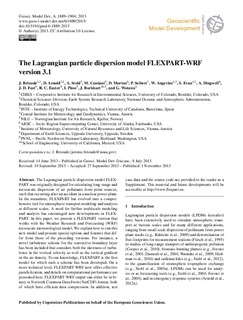| dc.identifier.citation | Brioude, J., Arnold, D., Stohl, A., Cassiani, M., Morton, D., Seibert, P., Angevine, W., Evan, S., Dingwell, A., Fast, J. D., Easter, R. C., Pisso, I., Burkhart, J., Wotawa, G. (2013). The Lagrangian particle dispersion model FLEXPART-WRF version 3.1. Geoscientific Model Development, 6, 1889-1904. doi:10.5194/gmd-6-1889-2013 | nb_NO |
| dc.description.abstract | The Lagrangian particle dispersion model FLEXPART was originally designed for calculating long-range and mesoscale dispersion of air pollutants from point sources, such that occurring after an accident in a nuclear power plant. In the meantime, FLEXPART has evolved into a comprehensive tool for atmospheric transport modeling and analysis at different scales. A need for further multiscale modeling and analysis has encouraged new developments in FLEXPART. In this paper, we present a FLEXPART version that works with the Weather Research and Forecasting (WRF) mesoscale meteorological model. We explain how to run this new model and present special options and features that differ from those of the preceding versions. For instance, a novel turbulence scheme for the convective boundary layer has been included that considers both the skewness of turbulence in the vertical velocity as well as the vertical gradient in the air density. To our knowledge, FLEXPART is the first model for which such a scheme has been developed. On a more technical level, FLEXPART-WRF now offers effective parallelization, and details on computational performance are presented here. FLEXPART-WRF output can either be in binary or Network Common Data Form (NetCDF) format, both of which have efficient data compression. In addition, test case data and the source code are provided to the reader as a Supplement. This material and future developments will be accessible at http://www.flexpart.eu. | nb_NO |

